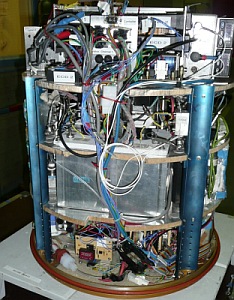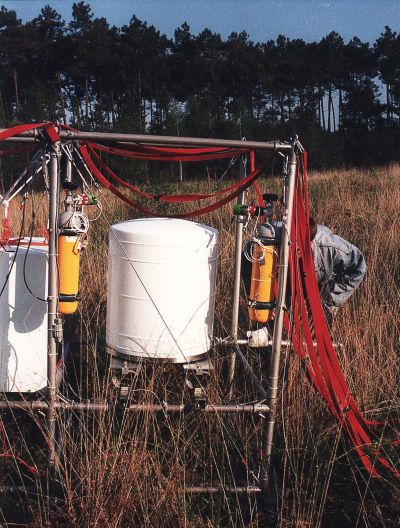Purpose of the flight and payload description
HAGAR is the acronym of High Altitude Gas AnalizeR a measurement device developed by the Institut für Atmosphären-und Umweltforschung an der Bergischen at Universität Wuppertal, Germany.
The instrument is an aircraft-based fast gas chromatograph for simultaneous in-situ measurements of trace gases like N2O, SF6, CH4, H2 as well as several halogen compounds in combination with an infrared sensor for CO2 measurements in the stratosphere.
Starting in 1999 the instrument was deployed several times on board the Russian high-altitude research aircraft Geophysica M-55 during many measurement campaigns around the world.
Just before its first aircraft deployment, HAGAR was balloon launched along with other instrument provided by the University of Cambridge in a lightweight gondola mainly used to host experiments for atmospheric measurements. At left we can see the instrument itself, while in the image at right we can see the instrument inside its pressurized vessel right after landing.
Details of the balloon flight
Balloon launched on: 5/13/1998 at 19:41 utc
Launch site: Centre de Lancement de Ballons CLBA, Aire Sur L'Adour, Landes, France
Balloon launched by: Centre National d'Etudes Spatiales (CNES)
Balloon manufacturer/size/composition: Zero Pressure Balloon model 35SF Zodiac - 35.000 m3
Balloon serial number: 35SF Nº 78
End of flight (L for landing time, W for last contact, otherwise termination time): 5/13/1998 at ~ 22:40 utc
Balloon flight duration (F: time at float only, otherwise total flight time in d:days / h:hours or m:minutes - ): 3 h 30 m
Landing site: 60 kms NW of Aire Sur L'Adour, France
Campaign: LITES
Payload weight: 434 kgs
Gondola weight: 148 kgs
The balloon was launched using the auxiliary balloon method, from the CNES base of Aire Sur L'Adour at 19:41 utc on May 13, 1998. The flight profile included a slow ascent up to 30 km and subsequent slow decent to obtain a vertical profile with good vertical resolution. The instrument worked stably, but the lack of active temperature control of the pressure vessel during this flight caused large temperature drifts accompanied by drifts of the detector signals.
External references
- HAGAR instrument University of Wuppertal
125If you consider this website interesting or useful, you can help me to keep it up and running with a small donation to cover the operational costs. Just the equivalent of the price of a cup of coffee helps a lot.



